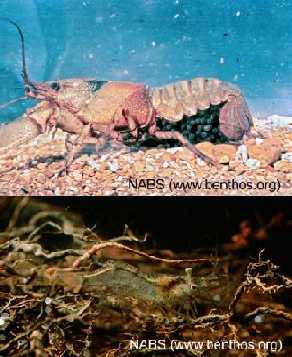Home → Water Quality → Monitoring & Reporting → Biomonitoring → Sampling & Analysis → Macroinvertebrate Types → Crayfish & Shrimps
 Crayfish & Shrimps (Decapoda)
Crayfish & Shrimps (Decapoda)
Crayfish and shrimps are members of a bottom dwelling class of crustaceans called Malacostraca. This class also includes aquatic sow bugs (Isopoda) and scuds (Amphipoda). With 315 freshwater species, crayfish are a much more diverse group than freshwater shrimp, of which there are only 19 species.
Crayfish and shrimps range from 10-150mm long. Their bodies are elongate and cylindrical. The body is composed of a 6 segment abdomen (tail)and a cephalothorax (Upper body and head) that is covered by a hard structure called a carapace. Like all crustaceans, they have an exoskeleton made of both calcium carbonate (a major material in snail and mussel shells) and chitin (the same material found in human fingernails). Crayfish and shrimp have two pairs of antennae, with one pair much longer than the other. They have 5 pairs of walking legs, with claws on the first 2-3 pairs. In crayfish the first pair of claws is enlarged, resembling those of a lobster. Crayfish can also be separated from shrimp by their color. Whereas crayfish are often mottled in shades of brown, red, orange, and green, shrimp are often gray, white, or sometimes transparent. All crustaceans reproduce sexually. Newly hatched juveniles look essentially like small adults. Crustaceans grow larger throughout their entire lives, shedding their hard exoskeleton when it is outgrown and generating a new one.
Crayfish and shrimps have very different habitat and feeding preferences. Crayfish are omnivores. They feed primarily on decaying vegetation, but they often consume live plants. In areas where crayfish are overpopulated they can remove most of the aquatic plants, drastically changing habitat that other invertebrates and some young fish depend on. They can also feed on snails, aquatic insects, eggs, and sometimes small fish. They will eat dead fish and scrape algae and microbes from the substrate. Crayfish can be found in shallow areas of both standing and flowing waters. They prefer complex substrate such as cobble, woody debris, plants, and course detritus that provide hiding places for their use when they are inactive during the day. Most crayfish feed primarily at night.
Unlike crayfish, shrimps feed primarily by scraping algae and microbes from the substrate, although they do occasionally prey on aquatic insects. They prefer still water habitats, including near shore areas of lakes and reservoirs as well as slower areas of large rivers. They are almost always found amongst aquatic plants.
Both crayfish and shrimps breathe dissolved oxygen through gills located beneath their carapace. Crayfish can withstand a wide range of temperature, pH, and alkalinities. They are very sensitive to toxics such as metals, insecticides, herbicides, and lampricides (chemicals introduced into the water to kill the parasitic fish called the lamprey). Species of crayfish that live in streams are generally less tolerant of pollution than species that live in lakes. The stress tolerance of shrimps is not well known, but it is presumed to be similar to crayfish.
Picture key
Top: A female crayfish (Orconectes punctimanus). Note the black eggs underneath her abdomen.
Bottom: A freshwater shrimp (Syncaris pacifica)
Source: Both photos are from The North American Benthological Society
Bibliography
Voshell, Jr., J. Reese; illustrated by Amy Bartlett Wright. 2002. A Guide to Common Freshwater Invertebrates of North America. Blacksburg (VA): The McDonald & Woodward Publishing Company. 442 p.